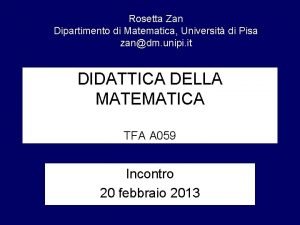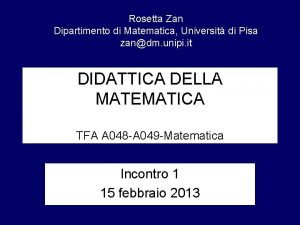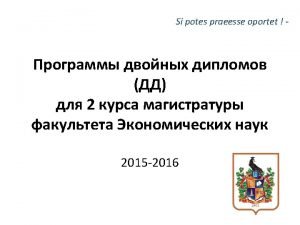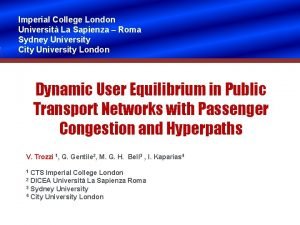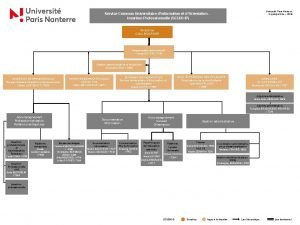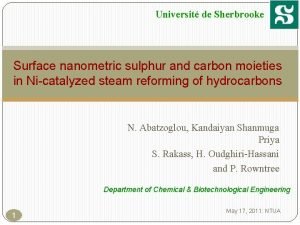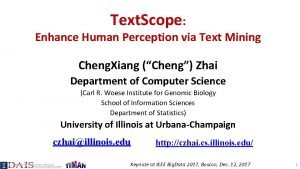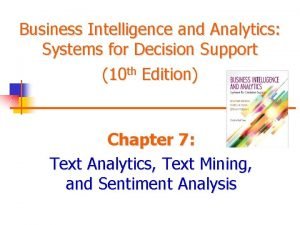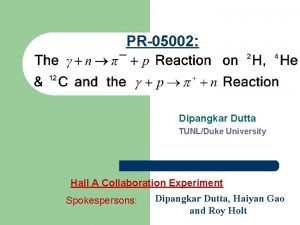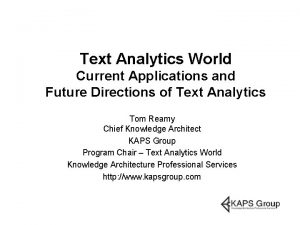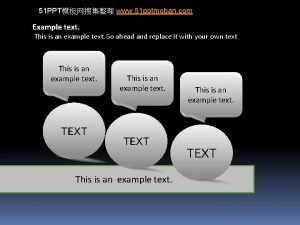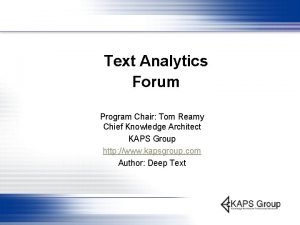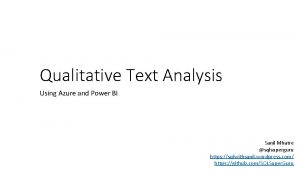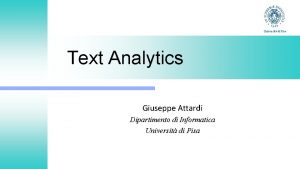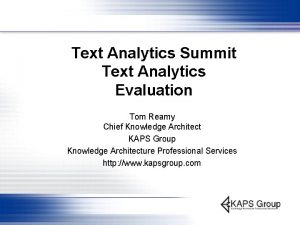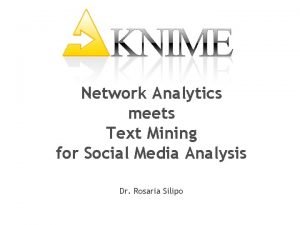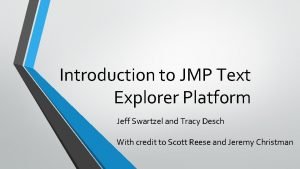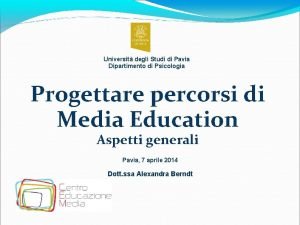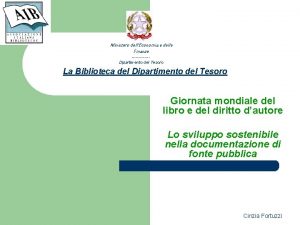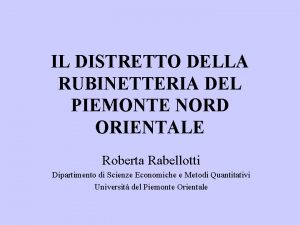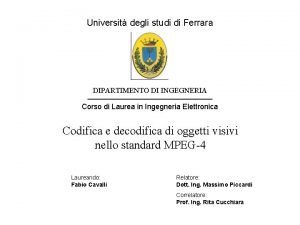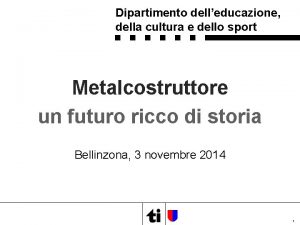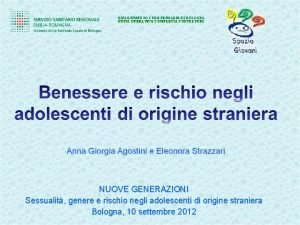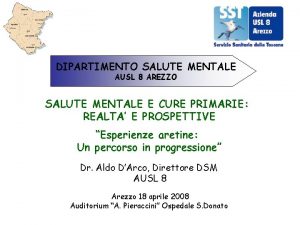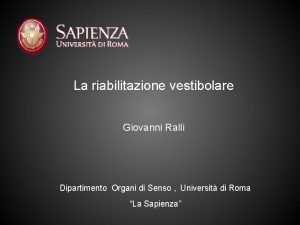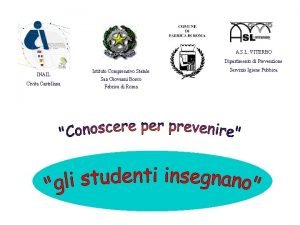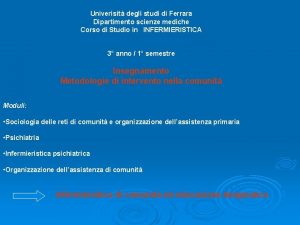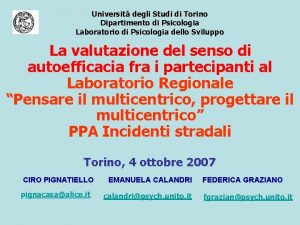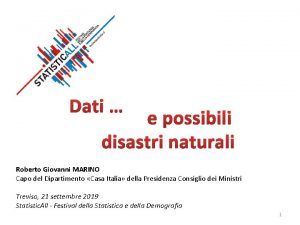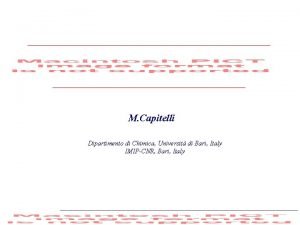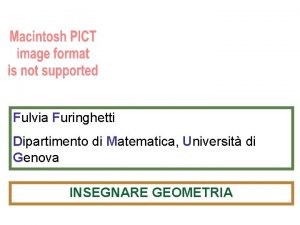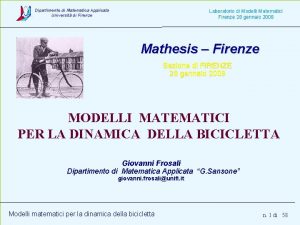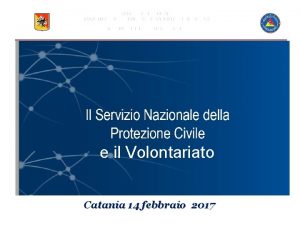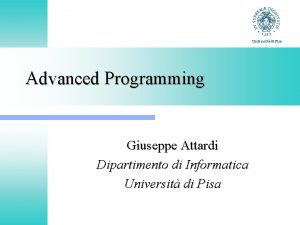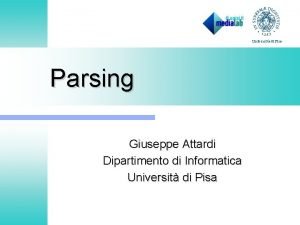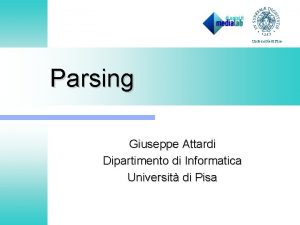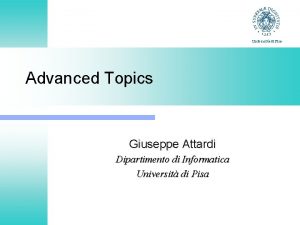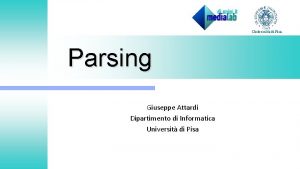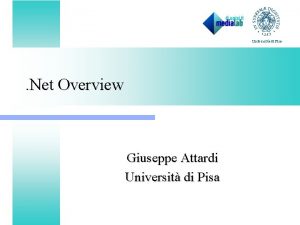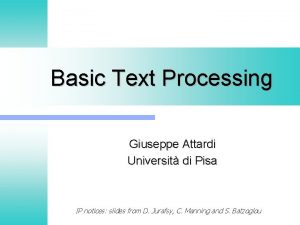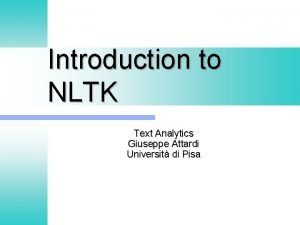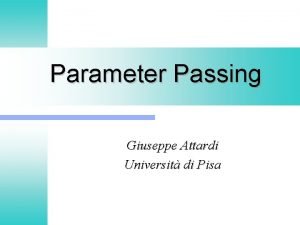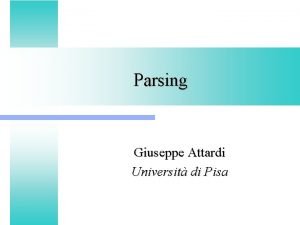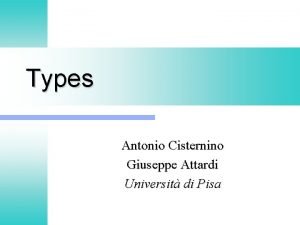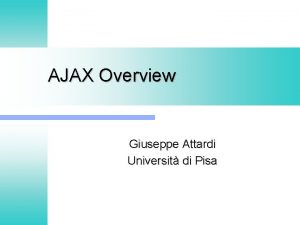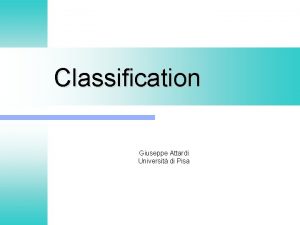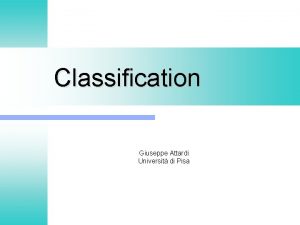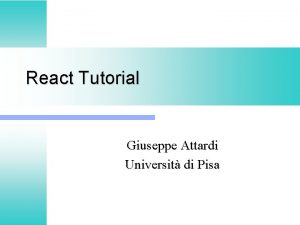Universit di Pisa Text Analytics Giuseppe Attardi Dipartimento




















































- Slides: 52

Università di Pisa Text Analytics Giuseppe Attardi Dipartimento di Informatica Università di Pisa

Instructors Giuseppe Attardi Office: 292 mail: attardi@di. unipi. it web: www. di. unipi. it/~attardi Andrea Esuli ISTI - CNR mail: andrea. esuli@isti. cnr. it web: http: //www. esuli. it/

Course Info l Course Page: § http: //didawiki. di. unipi. it/doku. php/mds/txa/start l Hours: § Monday 11 -13, Room X 1 § Tuesday 9 -11, Room X 1

Motivations Facts l Text is everywhere: § books, web, news § Humans communicate with text: • email, social media l Over 80% of information is expressed as unstructured data: § § 40 million articles in Wikipedia 4. 5 billion Web pages about 500 million tweets a day 1. 5 trillion queries in a year Definition Text analytics is the process of converting unstructured text data into meaningful data for analysis, to measure customer opinions, product reviews, feedback, to provide search facility, sentimental analysis and entity modeling to support fact based decision making.

Applications Traditional l l l analysis and classification of news reports filtering emails and spam extracting topics from web pages Database population Opinion mining automating ontology extraction management and collecting competitive intelligence Advanced Question Answering l Digital Assistants l Chatbots l

Natural Language Processing Sometimes simple statistical analysis of text is sufficient l Deeper analytics requires NLP capabilities l § Exploiting digital knowledge § Communicating with digital assistants l But often programmers are fazed by natural language § most people just avoid the problem and get into XML, or menus and drop boxes, or … l Are these solutions natural? § § Early days of computers, we had humans to learn computer languages Graphical User Interfaces, provided better for of interaction through visual form How can we teach language to computers? Or help them learn it as kids do?

Limitations of Desktop Metaphor

Personal Computing Desktop Metaphor: highly successful in making computers popular l Benefits: l § Point and click intuitive and universal l Limitations: § Point and click involves quite elementary actions § People are required to perform more and more clerical tasks § We have become: bank clerks, typographers, illustrators, librarians


The Dyna. Book Concept (1973)

Kay’s Personal Computer A quintessential device for expression and communication l Had to be portable and networked l For learning through experimentation, exploration and sharing l

An Ordinary Task Add a table to a document with results from latest benchmarks and send it to my colleague Antonio • • • 7 -8 point&click just to get to the document dozen point&click to get to the data lengthy fiddling with table layout 3 -4 point&click to retrieve mail address etc.

Prerequisites Declarative vs Procedural Specification l Details irrelevant l Many possible answers: user will choose best l

Going beyond Desktop Metaphor l Just one way: § Raise the level of interaction with computers l How? § Use natural language

NLP: Science Fiction l Star Trek § universal translator: Babel Fish § Language Interaction

September 2016 l Deep. Mind (an Alphabet company, aka Google) announces Wawe. Net: A Generative Model for Raw Audio

Early history of NLP: 1950 s l l l l Early NLP (Machine Translation) on machines less powerful than pocket calculators Foundational work on automata, formal languages, probabilities, and information theory First speech systems (Davis et al. , Bell Labs) MT heavily funded by military – a lot of it was just word substitution programs but there were a few seeds of later successes, e. g. , trigrams Little understanding of natural language syntax, semantics, pragmatics Problem soon appeared intractable Drop of funding to research Revival in ‘ 90 by introduction of statical approaches

Recent Breakthroughs l Watson at Jeopardy! Quiz: § http: //www. aaai. org/Magazine/Watson/watson. php § Final Game § PBS report l Google Translate on i. Phone § http: //googleblogspot. com/2011/02/introducing-google-translate-app-for. html l Apple SIRI

Smartest Machine on Earth IBM Watson beats human champions at TV quiz Jeopardy! l State of the art Question Answering system l

Tsunami of Deep Learning l l l Alpha. Go beats human champion at Go. Rank. Brain is third most important factor in the ranking algorithm along with links and content at Google Rank. Brain is given batches of historical searches and learns to make predictions from these It learns to deal also with queries and words never seen before Techniques like Word Embeddings

Dependency Parsing De. SR is online since 2007 l Stanford Parser l Google Parsey Mc. Parse. Face in 2016 l

Google “At Google, we spend a lot of time thinking about how computer systems can read and understand human language in order to process it in intelligent ways. ” l Parser used to analyze most of text processed l Parser used in Machine Translation l

Apple SIRI l l l ASR (Automated Speech Recognition) integrated in mobile phone Special signal processing chip for noise reduction SIRI ASR Cloud service for analysis Integration with applications

Google Voice Actions l l l Google: what is the population of Rome? Google: how tall is Berlusconi How old is Lady Gaga Who is the CEO of Tiscali Who won the Champions League Send text to Gervasi Please lend me your tablet Navigate to Palazzo Pitti in Florence Call Antonio Cisternino Map of Pisa Note to self publish course slides Listen to Dylan

NLP for Health “Machine learning and natural language processing are being used to sort through the research data available, which can then be given to oncologists to create the most effect and individualised cancer treatment for patients. ” “There is so much data available, it is impossible for a person to go through and understand it all. Machine learning can process the information much faster than humans and make it easier to understand. ” Chris Bishop, Microsoft Research

Health Care IBM Watson August 2016 l IBM’s Watson ingested tens of millions of oncology papers and vast volumes of leukemia data made available by international research institutes. l Doctors have used Watson to diagnose a rare type of leukemia and identify lifesaving therapy for a female patient in Tokyo. l Deep. Mind used million anonymous eye scans to train an algorithm to better spot the early signs of eye conditions such as wet age-related macular degeneration and diabetic retinopathy.

Technological Breakthrough Machine learning l Huge amount of data l Large processing capabilities l

Big Data & Deep Learning Neural Networks with many layers trained on large amounts of data l Requires high speed parallel computing l Typically using GPU (Graphic Processing Unit) l

Big Data & Deep Learning Google built TPU (Tensor Processing Unit) l 10 x better performance per watt l half-precision floats l Advances Moore's Law by 7 years l

Alpha. Go l TPU can fit into a hard drive slot within the data center rack and has already been powering Rank. Brain and Street View

Unreasonable Effectiveness of Data Halevy, Norvig, and Pereira argue that we should stop acting as if our goal is to author extremely elegant theories, and instead embrace complexity and make use of the best ally we have: the unreasonable effectiveness of data. l A simpler technique on more data beat a more sophisticated technique on less data. l Language in the wild, just like human behavior in general, is messy. l

Scientific Dispute: is it science? Prof. Noam Chomsky, Linguist, MIT Peter Norvig, Director of research, Google

Why to study human language?

AI is fascinating since it is the only discipline where the mind is used to study itself Luigi Stringa, director FBK

Language and Intelligence “Understanding cannot be measured by external behavior; it is an internal metric of how the brain remembers things and uses its memories to make predictions”. “The difference between the intelligence of humans and other mammals is that we have language”. Jeff Hawkins, “On Intelligence”, 2004

Hawkins’ Memory-Prediction framework The brain uses vast amounts of memory to create a model of the world. Everything you know and have learned is stored in this model. l The brain uses this memory-based model to make continuous predictions of future events. l It is the ability to make predictions about the future that is the crux of intelligence. l

Difference Between Data Science, Machine Learning and AI Post from David Robinson Statistics is used to find correlations in data Machine Learning is used to learn a model from examples to make predictions l Artificial Intelligence uses ML to extract a model of a human intelligence ability, to perform actions l l l § Humans in the loop are involved in providing examples of human behavior (e. g. annotating data, evaluating results) l Data Science uses statistical analysis of data to produce insights from statistical correlations § It uses humans in the end, who sift among those correlations hints to produce the insights § The intelligence lays in humans that interpret the output of statistical analysis

Thirty Million Words The number of words a child hears in early life will determine their academic success and IQ in later life. l Researchers Betty Hart and Todd Risley (1995) found that children from professional families heard thirty million more words in their first 3 years l http: //www. youtube. com/watch? v=q. Lo. EUEDqag. Q l

Linguistic Applications l So far self referential: from language to language § Classification § Extraction § Summarization l More challenging: § Derive conclusion § Perform actions

Natural Language Understanding is difficult l The hidden structure of language is complex and highly ambiguous Fed raises interest rates 0. 5% in effort to control inflation (NYT headline 5/17/00) Slide by C. Manning

Where are the ambiguities? Slide by C. Manning

Newspaper Headlines l l l l l Minister Accused Of Having 8 Wives In Jail Juvenile Court to Try Shooting Defendant Teacher Strikes Idle Kids China to Orbit Human on Oct. 15 Local High School Dropouts Cut in Half Red Tape Holds Up New Bridges Clinton Wins on Budget, but More Lies Ahead Hospitals Are Sued by 7 Foot Doctors Police: Crack Found in Man's Buttocks

Reference Resolution U: Where is The Green Hornet playing in Mountain View? S: The Green Hornet is playing at the Century 16 theater. U: When is it playing there? S: It’s playing at 2 pm, 5 pm, and 8 pm. U: I’d like 1 adult and 2 children for the first show. How much would that cost? l Knowledge sources: § Domain knowledge § Discourse knowledge § World knowledge

NLP is hard l Natural language is: § § § highly ambiguous at all levels complex and subtle use of context to convey meaning fuzzy? , probabilistic involves reasoning about the world a key part of people interacting with other people (a social system): • persuading, insulting and amusing them l But NLP can also be surprisingly easy sometimes: § rough text features can often do half the job

Hidden Structure of Language l Going beneath the surface… § Not just string processing § Not just keyword matching in a search engine • Search Google on “tennis racquet” and “tennis racquets” or “laptop” and “notebook” and the results are quite different … though these days Google does lots of subtle stuff beyond keyword matching itself § Not just converting a sound stream to a string of words • Like Nuance/IBM/Dragon/Philips speech recognition l To recover and manipulate at least some aspects of language structure and meaning

About the Course l Assumes some skills… § basic linear algebra, probability, and statistics § decent programming skills § willingness to learn missing knowledge l Teaches key theory and methods for Statistical NLP § Useful for building practical, robust systems capable of interpreting human language l Experimental approach: § Lots of problem-based learning § Often practical issues are as important as theoretical niceties

Experimental Approach 1. 2. 3. 4. 5. Formulate Hypothesis Implement Technique Train and Test Apply Evaluation Metric If not improved: 1. 2. 6. Perform error analysis Revise Hypothesis Repeat

Program l Introduction l § History § Present and Future § NLP and the Web l § § § Mathematical Background § § § Probability and Statistics Language Model Hidden Markov Model Viterbi Algorithm Generative vs Discriminative Models Linguistic Essentials l Part of Speech and Morphology Phrase structure Collocations n-gram Models Word Sense Disambiguation Word Embeddings Preprocessing § § § Encoding Regular Expressions Segmentation Tokenization Normalization

Program l Machine Learning Basics l § Deep Learning l l Introduction to Python NLTK Theano/Keras Tensor. Flow Text Classification and Clustering § Spam detection l § Constituency Parsing § Dependency Parsing Tools and Libraries § § Tagging § Part of Speech § Named Entity Linking Sentence Structure l Sentiment Analysis § Lexical Resources § Sentiment Classification § Opinion Extraction

Exam l Project

Previous Year Projects l Participation to Evalita 2011 § § § l Task POS + Lemmatization: 1 st position Task Domain Adaptation: 1 st position Task Super. Sense: 1 st position Task Dependency Parsing: 2 nd position Task NER: 3 rd position Participation to Evalita 2014 § Sentiment Analysis on tweets l Disaster Reports in Tweets Participation to Evalita 2016 § Task POS on Tweets: § Task Sentiment Polarity on Tweets: § Task Named Entity Extraction and Linking on Tweets l Sem. Eval 2012 § Sentiment Analysis on tweets l l Participation to Evalita 2018 § Task ABSITA on hotel reviews l Fujtsu NLP Grand Challenge § Winner

Books D. Jurafsky, J. H. Martin, Speech and Language Processing. 3 nd edition, Prentice-Hall, 2018. l S. Bird, E. Klein, E. Loper. Natural Language Processing with Python. l C. Manning, H. Schutze. Foundations of Statistical Natural Language Processing. MIT Press, 2000. l I. Goodfellow, Y. Bengio, A. Courville. Deep Learning. MIT Press, 2016. l
 Gerardo attardi
Gerardo attardi Dipartimento di economia pisa
Dipartimento di economia pisa Dipartimento matematica pisa
Dipartimento matematica pisa Dipartimento di matematica pisa
Dipartimento di matematica pisa Dipartimento di medicina clinica e sperimentale pisa
Dipartimento di medicina clinica e sperimentale pisa Rotterdam university economics
Rotterdam university economics London universit
London universit Université nanterre organigramme
Université nanterre organigramme Universit
Universit Universit sherbrooke
Universit sherbrooke Text-to-media connection
Text-to-media connection Text analytics and text mining
Text analytics and text mining Text analytics and text mining
Text analytics and text mining Teramond
Teramond Text analytics world
Text analytics world 51 ppt
51 ppt Text analytics forum 2019
Text analytics forum 2019 Power bi qualitative analysis
Power bi qualitative analysis Text analytics unipi
Text analytics unipi Text analytics summit
Text analytics summit Wziu hub
Wziu hub Idol text analytics
Idol text analytics Jmp recode
Jmp recode Dipartimento di psicologia pavia
Dipartimento di psicologia pavia Dipartimento del tesoro
Dipartimento del tesoro Dipartimento ingegneria civile unical
Dipartimento ingegneria civile unical Nord (dipartimento)
Nord (dipartimento) Dipartimento ingegneria ferrara
Dipartimento ingegneria ferrara Dipartimento dell'educazione della cultura e dello sport
Dipartimento dell'educazione della cultura e dello sport Dipartimento farmacia unical
Dipartimento farmacia unical Dipartimento economia genova
Dipartimento economia genova Direttore dipartimento pediatria sant' orsola
Direttore dipartimento pediatria sant' orsola Dipartimento cure primarie bologna
Dipartimento cure primarie bologna Dipartimento salute mentale arezzo
Dipartimento salute mentale arezzo Dipartimento di chimica pavia
Dipartimento di chimica pavia Dipartimento del tesoro
Dipartimento del tesoro Esercizi vestibolo oculari
Esercizi vestibolo oculari Inail civita castellana
Inail civita castellana Totalmente compensatorio
Totalmente compensatorio Ppa psicologia
Ppa psicologia Test psicologico militare
Test psicologico militare Dipartimento ingegneria trento
Dipartimento ingegneria trento Biblioteche unipr
Biblioteche unipr Dipartimento casa italia
Dipartimento casa italia Dipartimento organizzazione giudiziaria
Dipartimento organizzazione giudiziaria Dipartimento di chimica bari
Dipartimento di chimica bari Dipartimento di matematica genova
Dipartimento di matematica genova Dipartimento di matematica firenze
Dipartimento di matematica firenze Dipartimento di chimica unipv
Dipartimento di chimica unipv Dipartimento medicina perugia
Dipartimento medicina perugia Dipartimento delle istituzioni
Dipartimento delle istituzioni Dipartimento protezione civile regione sicilia
Dipartimento protezione civile regione sicilia Ilaria rizzato unige
Ilaria rizzato unige


